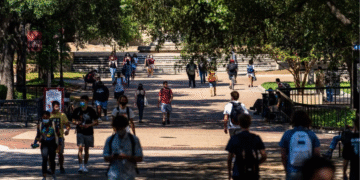A Memorial That Turned Into a Moment of Shock
What was meant to be a memorial — a place to reflect, mourn, and show respect — twisted into something many found deeply disturbing. On September 15, during a vigil at Texas State University in San Marcos, a student re-enacted what were claimed to be Charlie Kirk’s final moments. He imitated being shot in the neck, fell to the ground, spat near attendees, and used profane language. Around him, others chanted slurs and insulted the late conservative activist.
The video spread quickly online. For many watching, it crossed a line.
The Aftermath: Action, Outrage, and Accountability
Once the video went viral, public figures, students, and officials pushed for consequences. Texas Governor Greg Abbott was among those demanding the student be expelled, calling mocking an assassination “must have consequences.” University leadership responded swiftly. President Kelly Damphousse condemned the behavior, calling it “disturbing” and saying such actions “violate the values” of Texas State. Within hours, the student was no longer enrolled.
Voices of the Campus, Anger and Reflection
Students at Texas State are divided. Some say the conduct was hateful and disrespectful, a desecration of what should have been a solemn moment. Others defend the right to free speech, arguing that while the act was offensive, expulsion is a severe response.
A classmate noted that he felt the person was enraged, using the memorial as a platform for protest rather than reflection. Others worry that in trying to protect decency, institutions might suppress speech in ways that escalate tension instead.
What This Says About Today
There’s something painful about this moment. It’s not just about one student’s actions. It’s about how deeply polarized the public conversation has become — where grief and political identity, sorrow and outrage, are tangled so tightly that a memorial can become a battleground.
It asks uncomfortable questions:
- How do we balance respect for mourning with respect for free speech?
- When does protest become harm?
- And can institutions respond to outrageous behavior without fueling more division?
Lessons, and What Comes Next
Texas State University’s decision shows institutions can’t ignore moments that provoke widespread pain. But beyond expulsion, what happens now will matter: how the university supports students who were hurt, how students engage with each other when values clash, and whether respect can be restored without silence becoming the default.
Because at moments like this, silence isn’t always respectful — sometimes it’s complicity. And grief deserves more than shock. It deserves meaning.
















